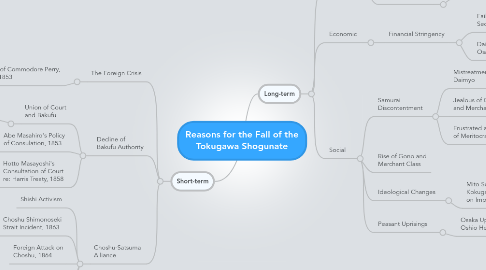
1. Long-term
1.1. Political
1.1.1. Lack of Meritocracy
1.1.1.1. Inept Leadership
1.1.2. Conflict Between Fundamentalists and Realists
1.1.2.1. Ineffective Reforms
1.1.2.1.1. Tempo Reforms, Early 1940's
1.2. Economic
1.2.1. Financial Stringency
1.2.1.1. Failure to Tax Growing Sectors of Economy
1.2.1.2. Daimyo Disadvantage in Osaka Rice Trade
1.3. Social
1.3.1. Samurai Discontentment
1.3.1.1. Mistreatment by Daimyo
1.3.1.2. Jealous of Gono and Merchant
1.3.1.3. Frustrated at Lack of Meritocracy
1.3.2. Rise of Gono and Merchant Class
1.3.3. Ideological Changes
1.3.3.1. Mito School and Kokugaku emphasis on Imperial Divinity
1.3.4. Peasant Uprisings
1.3.4.1. Osaka Uprising led by Oshio Heihachiro, 1837
2. Short-term
2.1. The Foreign Crisis
2.1.1. Arrival of Commodore Perry, July 3 1853
2.1.1.1. Kanegawa Treaty of Friendship, 1854
2.1.1.2. Harris Treaty, 1858
2.2. Decline of Bakufu Authority
2.2.1. Union of Court and Bakufu
2.2.1.1. Daimyo visiting Kyoto, 1863
2.2.2. Abe Masahiro's Policy of Consulation, 1853
2.2.3. Hotto Masayoshi's Consultation of Court re: Harris Treaty, 1858
2.3. Choshu-Satsuma Alliance
2.3.1. Shishi Activism
2.3.2. Choshu Shimonoseki Strait Incident, 1863
2.3.3. Foreign Attack on Choshu, 1864
2.3.4. Choshu defeat of Bakufu Army, 1866
2.3.5. Meiji Restoration, 1867-8
